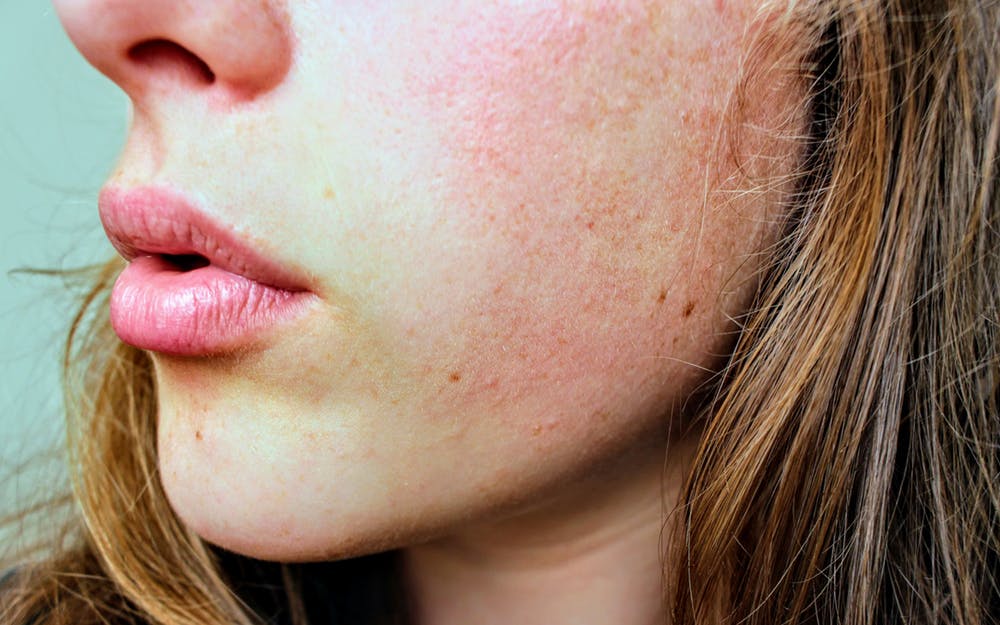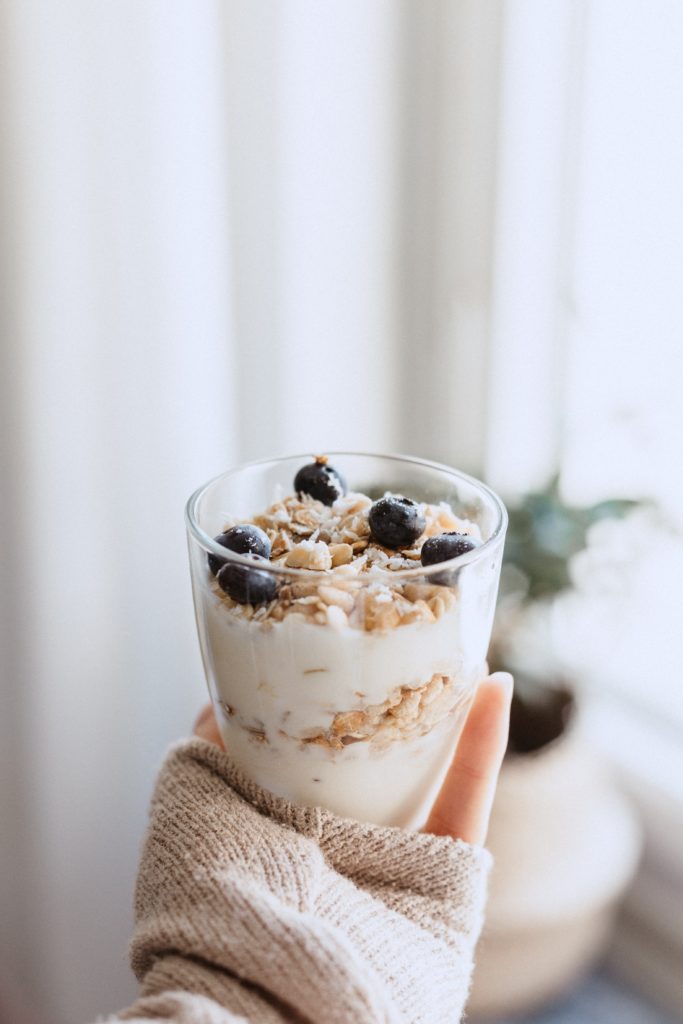If beauty is truly more than skin deep, could it be that your diet influences your rosacea symptoms? As a dermatologist, I’ve seen great results from using a rosacea diet to naturally treat redness, dry skin, bumps, and more.
I’ll look at major causes of rosacea, what foods can help improve rosacea symptoms, and the best natural remedy for this skin condition.
Treating food as medicine and following natural best practices, you can potentially avoid traditional medication’s possible side effects and use dietary changes to help clear up your rosacea. Read on to learn how.
How is diet connected to rosacea?
First, let’s start with a definition and some symptoms: one symptom of rosacea is a ruddy, red, or sunburned appearance on the skin of the face, eyes, ears, neck, or chest. One easy way to describe this symptom is a blushing skin tone that doesn’t go away.
Scientists suspect that this facial redness may be a result of ongoing inflammation. The symptoms of rosacea may include:
- Dry skin
- Flakiness
- Blood vessels that are more prominent or enlarged
- Bumps or raised patches
- Pimples or pustules
- Redness
Ocular rosacea, or rosacea affecting the eye area, may cause light sensitivity, tear production, blurry vision, and more eye symptoms. Severe rosacea patients may even experience an enlarged nose or chin and a thickening of the skin.
How is our diet connected to these seemingly random rosacea symptoms? Rosacea is linked to inflammation, which means you can avoid trigger foods and eat anti-inflammatory ones that reduce inflammation throughout the body to temper these symptoms.
While diet isn’t the only possible trigger for this inflammatory skin condition, it’s certainly one of the easiest to control. (Other possible irritants include sun exposure, emotional stress, weather, and even heavy exercise, according to the National Rosacea Society).
By limiting foods that are known to trigger rosacea, adding in foods that fight inflammation, and taking a holistic look at what could be causing your rosacea flare-ups, you can move toward a more even skin tone, less flaking, and smoother skin.
Rosacea Diet: Foods to Eat & Avoid
Like any other dietary treatment, there are certain foods to eat and others to avoid. You may notice certain foods that could be triggering outbreaks that are a part of your regular diet; if so, you may see major breakthrough by cutting them out.
In fact, rosacea has been connected to several digestive diseases, so a rosacea diet may have more positive effects than you think. A quality diet for rosacea puts the focus on alkaline foods and reduces your intake of acidic and inflammatory foods.
Here’s what to munch on — and what not to.
Foods to Eat
There are many delicious foods helpful to rosacea treatment, and who wouldn’t love eating their way to clearer skin? We’ll break these up into a few lists based on the ways they help to treat rosacea. Here’s what to add for a rounded rosacea diet.
Foods full of probiotics and prebiotics can help to balance the microbiome in the gut, reducing the inflammation in the gut. While probiotic capsules are fine, eating probiotic-rich foods is typically preferable for overall health.
Here are some fermented foods and prebiotic snacks that may give your gut bacteria a boost:
- Sauerkraut
- Kefir
- Kombucha
- Yogurt with live cultures
- Beet juice
- Tempeh
- Pickled fruits and veggies
- Bananas
- Onions
- Kale
- Whole grains
Foods packed with good bacteria, or the prebiotics that feed it, can balance your body’s microbiome, leading to improved overall health and a potential for less inflammation. Some rosacea suffers may notice some gas and bloating when eating probiotic and prebiotic rich foods and you may want to start with small quantities and see how your body responds and gradually add them into your meals.
Specific, unprocessed foods that have anti-inflammatory qualities are also important in a rosacea diet, supporting your immune system. Here are some of the best foods to fight inflammation:
- Asparagus
- Cauliflower
- Cucumber
- Lean poultry
- Leafy greens
- Pumpkin
- Sweet potatoes
- Zucchini
- Turmeric
- Foods high in omega-3s (salmon, ghee, flax seeds)
In addition to these foods that lower inflammation on a rosacea diet, some rosacea supplements may be needed to balance out the body’s inflammation levels and microbiome. These supplemental nutrients include:
- Omega-3 fatty acids (found in mackerel, salmon, cod liver oil, and chia seeds)
- Probiotics
- Flaxseed oil
With these powerful supplements and anti-inflammatory foods, you’re on your way to a happier gut and, by extension, a calmer complexion and fewer rosacea flare-ups.
Foods to Avoid
A mounting body of research has linked certain inflammatory foods to worsening rosacea symptoms. This list of dietary triggers may include:
- Refined sugars
- Processed sweets or sugary juices
- White flour (or gluten)
- Fried foods
- Alcoholic beverages
- Hot coffee, hot tea, or other hot beverages
- Spicy foods or spices like clove, cayenne, or black pepper
- Hot sauce
- Processed meats
- Foods that have additives or preservatives
- Artificial sweeteners
- Starchy vegetables and foods
- Foods that contain cinnamaldehyde (common examples include tomatoes, citrus fruits, chocolate, and cinnamon)
- Cheese
- Avocados
- Spinach
All of these foods can cause an inflammatory response, which causes a chemical reaction, swelling, redness, and often pain and heat. These reactions take a toll on the immune system and can contribute to both the look and the underlying cause of rosacea.
Other Possible Rosacea Triggers
Diet can help, but other sneaky triggers can also contribute to rosacea. Consider other factors, like:
- Demodex mites
- Certain skin care products, cleansers, and make-up
- Extreme hot or cold
- High humidity
- Sunlight
- Anxiety or other emotional stress
- Menopause
- Chronic coughing
- Certain medications (like niacin, blood pressure drugs, and ones containing capsaicin)
- Overuse of antibiotics or antacids
- Steroids
- Bacterial overgrowth
- Other individual issues
As you can see, a rosacea diet may not clear up the issue on its own, though it can aid in treating the underlying issue. So, what are the best practices for treating rosacea?
Treating Rosacea: Best Practices
While the common practice is to prescribe antibiotics or topical medications for treating rosacea, I always believe that best practices include a more holistic approach.
Treating rosacea from the inside out means understanding your personal triggers and reducing them. Try these natural options as a support to your rosacea diet:
- Consistently wear organic, broad-spectrum SPF to avoid overexposure to the sun.
- Be gentle with your skin — avoid scrubbing too hard or using harsh products (like ones containing alcohol, exfoliating agents, fragrances, or menthol).
- Avoid hot drinks and alcohol whenever possible.
- Use organic moisturizers to keep your skin hydrated and protected.
- In extreme cases, talk to your dermatologist about more intensive dermatology options, like laser treatments to refinish the skin.
- Your dermatologist may also recommend a topical cream or gel to help soothe your skin.
With these natural and dermatological options, there are plenty of positive practices and self-care measures that can help reduce the look and frustration of rosacea.
In Summary
- While rosacea is a common skin condition that affects many people, it’s able to be managed through diet.
- Rosacea, a ruddy or red look generally caused by inflammation, is often accompanied by flakiness, dry skin, bumps or pimples, and prominent blood vessels.
- While it’s common to feel embarrassed by this condition, diet can reduce its appearance by adding in foods that support gut bacteria, foods that fight inflammation, and supplements that help with the underlying causes of this skin condition.
- Avoiding processed foods that are high in sugar, histamines, and certain chemicals can also remove the cause of inflammation, further reducing the symptoms of rosacea.
- While diet is certainly a major player in rosacea, other factors such as emotional stress, weather conditions, medications, and sunlight exposure can worsen the appearance of rosacea.
- Thankfully, there are many best practices including using organic sunscreen and moisturizers, treating your skin gently, and carefully selecting your products that your dermatologist can guide you through as you create the best plan for treating your rosacea.
- With a rosacea diet and natural treatments, you can treat the hidden issues causing your flare-ups and heal your skin through a holistic treatment!
Sources
- Mikkelsen, C. S., Holmgren, H. R., Kjellman, P., Heidenheim, M., Kappinnen, A., Bjerring, P., & Huldt-Nystrøm, T. (2016). Rosacea: a clinical review. Dermatology reports, 8(1). Full text: https://www.ncbi.nlm.nih.gov/pmc/articles/PMC5134688/
- Joerg, B., & Steinhoff, M. (2018). Recent advances in understanding and managing rosacea. F1000Research, 7. Full text: https://www.ncbi.nlm.nih.gov/pmc/articles/PMC6281021/
- Egeberg, A., Weinstock, L. B., Thyssen, E. P., Gislason, G. H., & Thyssen, J. P. (2017). Rosacea and gastrointestinal disorders: a population‐based cohort study. British Journal of Dermatology, 176(1), 100-106. Abstract: https://www.ncbi.nlm.nih.gov/pubmed/27501017
- Homayoni Rad, A., Vaghef Mehrabany, E., Alipoor, B., & Vaghef Mehrabany, L. (2016). The comparison of food and supplement as probiotic delivery vehicles. Critical reviews in food science and nutrition, 56(6), 896-909. Abstract: https://www.ncbi.nlm.nih.gov/pubmed/25117939
- Weiss, E., & Katta, R. (2017). Diet and rosacea: the role of dietary change in the management of rosacea. Dermatology practical & conceptual, 7(4), 31. Full text: https://www.ncbi.nlm.nih.gov/pmc/articles/PMC5718124/
- Odom, R., Dahl, M., Dover, J., Draelos, Z., Drake, L., Macsai, M., … & Wilkin, J. (2009). Standard management options for rosacea, part 1: overview and broad spectrum of care. Cutis, 84(1), 43. Abstract: https://www.ncbi.nlm.nih.gov/pubmed/19743724
- Jarmuda, S., O’Reilly, N., Zaba, R., Jakubowicz, O., Szkaradkiewicz, A., & Kavanagh, K. (2012). The potential role of Demodex folliculorum mites and bacteria in the induction of rosacea. Journal of medical microbiology, 61(11), 1504-1510. Abstract: https://www.microbiologyresearch.org/content/journal/jmm/10.1099/jmm.0.048090-0#tab2
- Rivero, A. L., & Whitfeld, M. (2018). An update on the treatment of rosacea. Australian prescriber, 41(1), 20. Full text: https://www.ncbi.nlm.nih.gov/pmc/articles/PMC5828925/
- Two, A. M., Wu, W., Gallo, R. L., & Hata, T. R. (2015). Rosacea: part II. Topical and systemic therapies in the treatment of rosacea. Journal of the American Academy of Dermatology, 72(5), 761-770. Abstract: https://www.ncbi.nlm.nih.gov/pubmed/25890456
- Huynh, T. T. (2013). Burden of disease: the psychosocial impact of rosacea on a patient’s quality of life. American health & drug benefits, 6(6), 348. Full text: https://www.ncbi.nlm.nih.gov/pmc/articles/PMC4031723/




